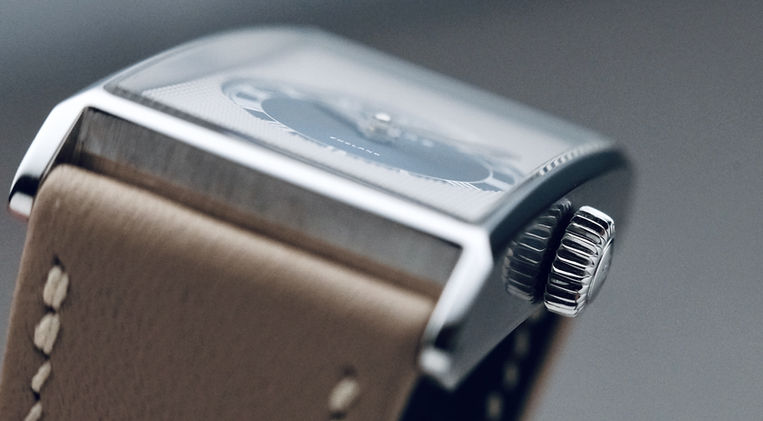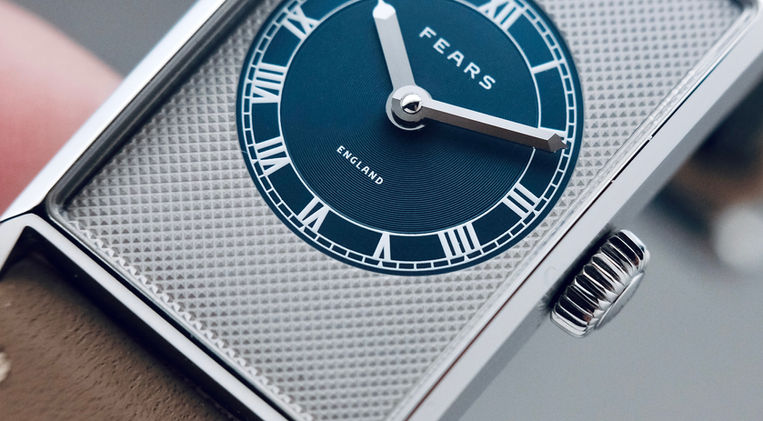Fears Arnos Pewter Blue
The Most Interesting Shaped Watch of the 21st Century
June 5, 2025
There isn’t a more classic watch than the rectangular one pioneered and iconized by Cartier, the Tank. Since 1917, it sits at the pinnacle of horological design and is as emblematic for watchmaking as the T-Model Ford is for car manufacturing or the Ray Ban’s Aviators are for sunglasses. The Tank has been homaged, recreated, re-interpreted, and reinvented many times over in the past century and more, as many brands have attempted to make a watch as ubiquitous as the Cartier. It’s classic and is a classic of wristwatch aesthetic worn by the most famous, and perhaps sometimes controversial, people on Earth. From politicians and singers to boxers and your grandmother. And many well established brands have made their own successful versions of the rectangular watch, for example Jaeger-LeCoultre with the Reverso and Longines with the Dolce Vita. Let’s not forget the numerous micro and independent brands which have taken a crack at it, alas, often without great results.
It seems that the problem with creating a rectangular watch nowadays stems from the power the Tank has had on our collective knowledge of watchmaking since the early 20th century. We all know the Tank even though we don’t all love it. And its design is so particular that it seems almost impossible to make a rectangular watch without using Roman numerals, or to use Roman numerals without designing the same watch, or to make a rectangular watch with a different rectangular case or to use a different case profile without using the same dial. Many brands have made the attempt of creating a new rectangular watch and most have failed. But…through this article we’re going to dissect a rectangular watch that’s finally it. And it appears as though there was only one brand which could have pulled it off: Fears. The historical Bristol brand created its first rectangular watch in 1930 and today, under Nicholas Bowman-Scargill, the Arnos Peweter Blue is the first noteworthy rectangular watch of our time.
Talk about a hot take!

Specifications
Watches hold tremendous psychological power over us. They can modify the way we think of ourselves and the world through a specific combination of metal, glass, and wheels, organized in a coherent manner. And that is true regardless of the shape and size of said watch. For a reason which has yet to be scientifically or psychologically explained, rectangular watches transform us into refined, intellectual, and discerning collectors and that is true even for those who never saw themselves as being able to wear this kind of watch. There is something contrarian about rectangular watches as it is not a shape found in nature, and perhaps then wearing such a watch really stands out for it breaks the natural symmetry of our body and appears like a blockade on our wrist. Because it is the shape of the Fears Arnos which first drew me in—all 22.6mm width and 40mm length of it. It is an oblong rectangle made more striking by the circular dial contained within its walls.

8.6mm thin, the Fears Arnos is extremely comfortable to wear on account of its physical dimensions as well as the fastening systems it comes with: a thin, soft, and supple taupe Barenia calf leather strap and a smooth blue cut-to-size FKM rubber strap complete with a leaf-spring scissor clasp. But don’t be fooled by the seemingly classic and old-school appearance of the Arnos as it is built to fit the modern environment and contemporary lifestyles of today’s watch enthusiasts, complete with a curved sapphire crystal, an automatic Sellita SW1000-1b caliber (4Hz/40 hours of power reserve,) a reasonable 30 meters of water resistance which is enough for this kind of watch, and rhodium-plated hands which won’t tarnish overtime. Built the way it is, I have the feeling that the Arnos would look as good and function as well today as it would 50 years from now. It has therefore all of the required mechanical specifications to shine through the generations.
But there’s more.

Design
The circle in a rectangle design of the Arnos came to Nicholas in a quasi Dr. Emmett Brown’s moment, unplanned and almost magical, a what-if idea. Metaphophorically speaking, we like to ask ourselves how we could put a square peg inside a round hole, combining together two shapes which aren’t supposed to work. Odd combinations aren’t new but they are rare, and generally a rectangular watch comes with a rectangular dial, a circular watch with a circular dial, and an hexagonal watch with an hexagonal dial. Therefore the two main design elements of the watch have to generally match but here they don’t. And that’s what makes the Arnos so beautiful. In a way, it emphasizes the idea that a rectangular timekeeping device isn’t natural by relaying our natural inclination (or habit) for circular watches through the center dial. The latter is small but large enough to be legible and the whole ensemble displays a beautiful juxtaposition of different finishes.

So let’s talk about this dial…actually, the dials. There is an inner dial and an outer one, where the former is recessed and made of two types of finishes: a machine-turned radial pattern at its center and a matte finished one at its periphery. After being machined, the dial plate was coated in galvanic blue (galvanized with a blue tinted zinc coating for extra resistance to tarnishing) before that the hour markers and minute track were pad-printed in white. The printing on both sections of the inner dial is crisp and contrasts perfectly with the blue backdrop, making it easy to read the time and set the time to the almost precise minute. (There is no running seconds hand.) The outer dial showcases a CNC-machined hobnail pattern—a flat nail with a flat top which also looks like a pyramid seen from above— beautifully three-dimensional and coated in rhodium for…you know what. I believe Fears found the perfect combination of colors and patterns here.

But there’s more.
The hands the Arnos is equipped with are what the brand calls “Fears Pipette” shaped hands—“Pipette” is the French word for the long and thin suctioning tool used to draw liquids from a dish or a test tube—which are diamond cut and faceted. The main sections of the hands are formed by two chamfers which appear to form a mountain peak, whilst the tip is made of another chamfer cut perpendicularly and with a concave profile. (Each facet has a flat base even though it’s impossible to see them with the naked eye.) The case for its part is no less fascinating, borrowed from Fears’ Archival 1930, whose striking features are the thin bezel, the noticeable polished chamfers, and the slab-sided flanks showcasing a fine horizontal brushing. The narrow but tall case is what endows the Arnos with such a powerful and contrarian wrist presence. The icing on the case is the 5.7mm semi-onion-shaped pull/push crown decorated with the brand’s Cypher (logo.)

The Heart of the Matter
To go back to raison d’être and popularity of rectangular watches, initiated by the Cartier Tank more than a century ago, one of the two main distinguishing characteristics of the Fears Arnos, which set it apart from the numerous similarly-shaped watches, is the quality of its manufacturing and inherent everyday wearability. And that to me is quite interesting. Rhodium-plated hands and outer dial section as well as a galvanized inner dial, are things we rarely—if ever—see on tool watches let alone dressier ones. Which shows that the brand has the unique capacity and motivation to make extra solid watches regardless of what they look like (the Redcliff 39.5 was equally well built.) Add to that the bespoke nature of the curved case, curved case-back, and curved sapphire crystal, you do get an exceptionally manufactured timekeeping device whose value goes beyond its basic shape and de facto elegant nature. It’s a full and odd package if you will which I believe only Fears could create.

Then add the complexity of the dial, of its design and construction, with the various textures and finishes and coatings to make it precise, three-dimensional, and durable. And the deceptively simple concept of putting a small and circular inner dial inside a rectangular outer dial—creating a big and beautiful negative space (hope you get and accept the joke!)—encased into an ultra vintage looking case. And further add to that the fact that Fears gets the dials done in Germany, the cases in Switzerland, and hand assembles the watches in England—then how much do you reckon you should spend on the Arnos? I will tell you: $4,500 USD excluding taxes, $5,400 USD with. I don’t know about you but that seems like an appropriate sum of money to acquire what certainly is the most interesting shaped watch of the 21st century. Fears watches are never cheap, and I know many would prefer if they were more affordable, but as far as I can tell, they’re worth every penny.

Conclusion
A lot has happened since 1917 and the global watch community had to wait 108 years in order to be presented with a watch strong of the supreme potential to redefine horological design and become an icon of its generation. I know I’m being very enthusiastic here and highly praisy of Fears—of Nicholas and his team—because I think it’s the appropriate thing to do. And I would explain that in a very Vincent-centered manner: I’m a tool watch guy and the Arnos stole my heart in Geneva earlier this year. I had the privilege of seeing dozens upon dozens of watches from brands praised, admired, cherished, and loved, at prices ranging from a couple of thousands of dollars to private-space-travel-level of financial abyss, and the Arnos quietly stole the show. It’s exquisite in all senses of the words and from all angles, and so I hope you would consider taking a closer look at it on the brand’s website.
Thanks for reading.








































